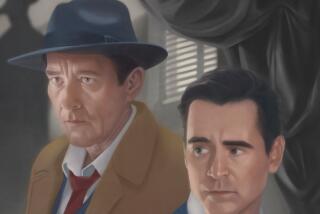For Geoffrey Rush, There’s an Acting Method to the Madness
- Share via
NEW YORK — After winning the Academy Award for playing the mentally ill pianist David Helfgott in “Shine” (1996), Geoffrey Rush went to see the real Helfgott perform in London.
“It became an essential time to close that chapter in my life,” Rush said during a recent interview. “And it was a fantastic way of doing it, to see him triumph on so many levels.”
Rush may have ended the phase in which he rose from an Australian stage actor into an international film star, but his exploration of madness continues.
He plays the Marquis de Sade during the writer’s final asylum stay in “Quills.” The 49-year-old Rush again embraces the mentally ill, the misunderstood, the ostracized.
“Actors play outlaws in westerns without in any way diminishing their capability within that framework, because that’s what creates pretty good drama,” Rush said. “I’m not overly worried about the roles of extremity because that’s the area of characterization that interests me.”
“Quills,” as envisioned by director Philip Kaufman (“The Right Stuff” and “Henry & June”) and screenwriter Doug Wright, asserts that Sade’s compulsion to write matched his perversion. When the institution takes away his quill and ink as punishment, Sade writes in blood. When it takes away his paper, he writes on clothing and bedding.
Rush’s Sade is a charmer who is ready to inflict his cruel-to-be-kind brand of seduction on any takers, including the laundress (Kate Winslet), the priest (Joaquin Phoenix) and the doctor (Michael Caine).
“Is he intimidating or alluring?” Kaufman asked. “Geoffrey plays that very thin line. He’s all things to all sexes, and he’s dangerous.”
Sade was a prolific author in the late 1700s and early 1800s, besides being the root of the word “sadism.” A convicted rapist, he churned out books of sex and torture that outraged Napoleon and cost him 29 years of his adult life in French prisons, hospitals and asylums.
Sade is not the kind of figure many Oscar winners would portray. Instead of taking his statuette to the bank, Rush clung to his stage origins, appearing in a run of period film pieces such as “Elizabeth” (1998), “Les Miserables” (1998) and “Shakespeare in Love” (1998). For the latter, he earned a best supporting actor nomination as a sleazy theater owner. “I feel connected to theatrical repertoire,” he said.
Rush is puzzled by the critics who have accused him of mismanaging his career following the Oscar victory.
“If you look at the history of it, actors’ careers take quite different paths,” he said. “I don’t think it’s a calling card for what the big studios tend to produce now.”
There is little chance of Rush being ignored in “Quills,” not with extended nude scenes. The real Sade was a fat, wheezing mess toward the end of his life. Kaufman let Rush stay at his fighting weight for a more vital Sade. Rush joked that in his next movie, based on John LeCarre’s “The Tailor of Panama,” “I wear smart Savile Row suits and keep them on all the way through.”
Rush recently took five months off, saying he had served his apprenticeship in movies and needed time to reflect. It was just five years ago when director Scott Hicks saw Rush performing in a regional mounting of “The Importance of Being Earnest” and signed him up to star in “Shine.” Rush had never acted in a movie.
Rush said he felt the pressure of his newly minted Oscar when he was on the set of “Les Miserables” in Prague, Czech Republic, with an international cast.
“You have to let that go,” he said. “You have to go back to questions that drive you when you’re creating a play for an audience in a 400-seat theater.”
Rush is not all about heaving-bosom period pieces and bad teeth. He played the Vincent Price character in a remake of “The House on Haunted Hill” (1999) and was a disco despot in “Mystery Men” (1999).
Sade is his biggest role since “Shine.” Rush came armed with background and a sense of humor.
Said Wright: “He did all the necessary historical research that a classical actor should do, and then he’d grab us in the hallway before a scene and say, ‘This moment’s very Barbara Stanwyck, isn’t it?’ ”
No, it was very Geoffrey Rush.
More to Read
Only good movies
Get the Indie Focus newsletter, Mark Olsen's weekly guide to the world of cinema.
You may occasionally receive promotional content from the Los Angeles Times.









